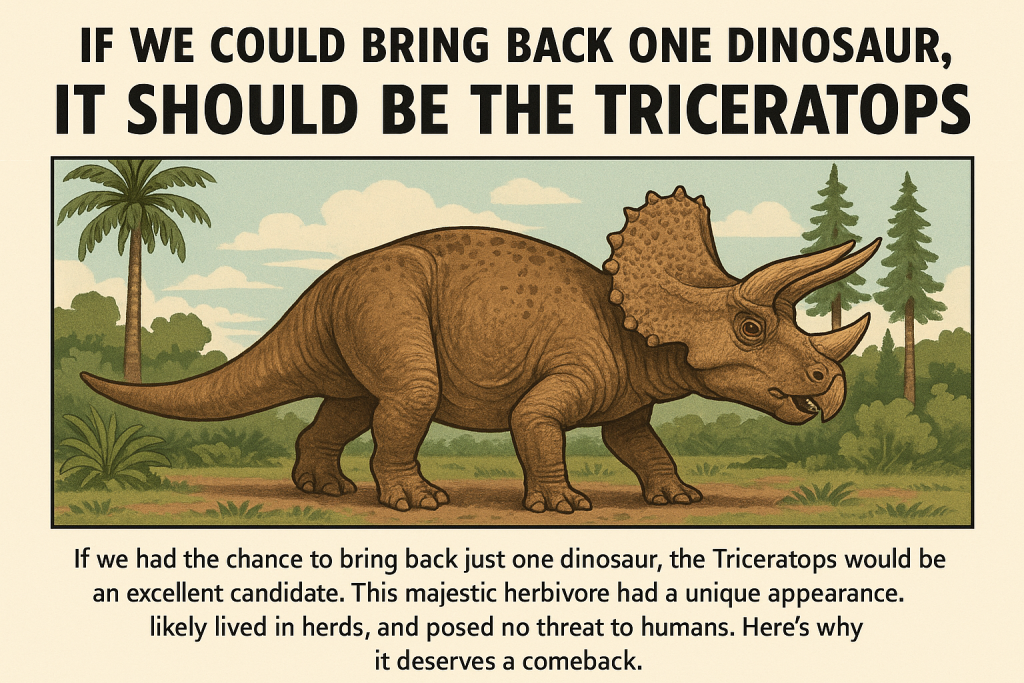⏲️ Estimated reading time: 5 min
If you could bring back one dinosaur, which one would it be?
If We Could Bring Back One Dinosaur, It Should Be the Triceratops. If we had the chance to bring back just one dinosaur, the Triceratops would be an excellent candidate. This majestic herbivore had a unique appearance, likely lived in herds, and posed no threat to humans. Here’s why it deserves a comeback.
If We Could Bring Back One Dinosaur, It Should Be the Triceratops
Dinosaurs have captured the imagination of people for centuries. From towering carnivores like Tyrannosaurus rex to mysterious flyers like Pteranodons, these prehistoric creatures leave us in awe. But if science allowed us to resurrect just one species, which should we choose?
Among the many incredible options, Triceratops stands out not for its ferocity, but for its balance between size, character, and safety. Let’s explore why this dinosaur might be the best candidate to walk the Earth again.
What Made the Triceratops Unique?
The name Triceratops means “three-horned face,” and this defining feature is what most people remember. But there’s more to this dinosaur than its headgear.
- Three iconic horns: Two above the eyes, one on the nose.
- A giant frill: Possibly used for defense, mating rituals, or thermoregulation.
- Size and strength: Up to 30 feet long and weighing 6–12 tons.
- Plant-based diet: It was strictly herbivorous.
- Late Cretaceous resident: Lived around 68–66 million years ago.
Unlike the T-Rex or Velociraptor, the Triceratops wasn’t a predator. Its calm, defensive nature would make it easier to manage if brought back to life.
Safe for Human Interaction
Let’s be honest. Bringing back a T-Rex might sound thrilling, but keeping one safely contained would be a nightmare. Triceratops, on the other hand, is far more manageable:
- Herbivore: No risk of it eating humans.
- Predictable behavior: As a prey animal, its movements would likely be cautious and less aggressive.
- Non-territorial: Unlike apex predators, Triceratops probably lived in groups and focused on survival, not domination.
If introduced in secure, controlled environments, Triceratops could even become an educational attraction, similar to elephants or rhinos in wildlife parks.
A Social Dinosaur
Fossil records and comparisons to other ceratopsians suggest that Triceratops may have lived in herds. This would have meant structured social behavior, likely including:
- Parental care for young dinosaurs.
- Protective group movement against predators.
- Vocal and visual communication, possibly through horn and frill displays.
Bringing back a species with such potential for complex behavior would offer scientists and educators a treasure trove of information about ancient ecosystems.
Ecological Considerations
Reviving extinct species, a concept called de-extinction, is still theoretical and controversial. If ever pursued, ecological balance must be prioritized.
Triceratops, as a herbivore, could be managed in designated biospheres or preserves where its impact on modern flora could be monitored. Unlike a predator, its dietary habits could be better predicted and controlled.

Why Not the T-Rex?
Tyrannosaurus rex is probably the most famous dinosaur in the world. But bringing it back would introduce countless risks:
- Top-tier predator: Hard to feed and dangerous.
- Massive land requirements: Needs a large territory.
- Unpredictable aggression: Even with advanced containment, risks are too high.
Triceratops, in contrast, offers awe without the apocalypse.
Triceratops in Pop Culture
Triceratops has long been a favorite in books, films, and museums. From The Land Before Time‘s Cera to Jurassic Park‘s sick Triceratops scene, it’s been depicted as:
- Loyal
- Brave
- Strong
- Defensive but not violent
This cultural significance would make its real-life return even more exciting for dinosaur fans of all ages.
The Science Behind De-Extinction
To truly bring back the Triceratops, scientists would need:
- Well-preserved DNA: Currently unavailable for non-avian dinosaurs.
- A compatible egg donor species: No living relatives exist, unlike birds and mammoths.
- Genome editing tools: Like CRISPR, to reconstruct lost genes.
At this time, the idea remains in the realm of possibility but not practicality. However, research into ancient DNA and synthetic biology is accelerating.
Could Triceratops Coexist With Us?
Hypothetically, yes under very specific conditions:
- Large enclosures
- Strict ecological controls
- Ethical breeding policies
- Strong veterinary and behavioral science support
Think of how we manage elephants or bison today, but with prehistoric grandeur.
Would You Visit a Real-Life Jurassic Park?
If Triceratops were brought back safely, would you go see it? Imagine walking through a modern-day sanctuary, hearing the soft grunts of a massive three-horned creature grazing peacefully in a distant field. It would be a moment of wonder, learning, and humility.
We can’t revive all of Earth’s ancient giants, but if we get just one chance Triceratops would be a noble, safe, and inspiring choice.
Final Thoughts
Bringing back a dinosaur is not just about science fiction fantasies it’s about responsibility, wonder, and learning. The Triceratops offers the best blend of visual fascination, behavioral complexity, and safety. It’s a symbol of strength without savagery and a reminder that not all giants were predators.
🔔 For more tutorials like this, consider subscribing to our blog.
📩 Do you have questions or suggestions? Leave a comment or contact us!
🏷️ Tags: dinosaurs, triceratops, prehistoric life, de-extinction, Jurassic Park, herbivorous dinosaurs, dinosaur science, extinct animals, science fiction, paleontology
📢 Hashtags: #Triceratops, #Dinosaurs, #PrehistoricLife, #DeExtinction, #Paleontology, #JurassicPark, #HerbivoreDinosaur, #ScienceFacts, #ExtinctAnimals, #AncientCreatures
🦕 Ancient Reflections
The idea of resurrecting the Triceratops isn’t just a paleontologist’s dream it’s a symbol of what responsible science might one day achieve. It reminds us of the past while pointing toward the ethical possibilities of the future.
Only logged-in users can submit reports.
Discover more from HelpZone
Subscribe to get the latest posts sent to your email.

